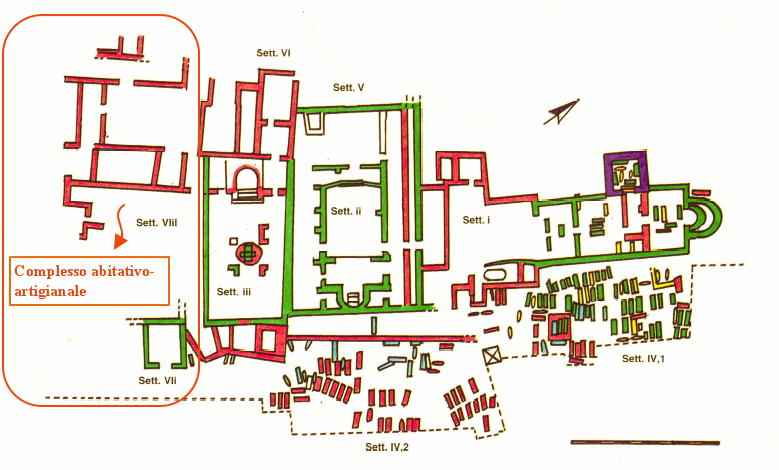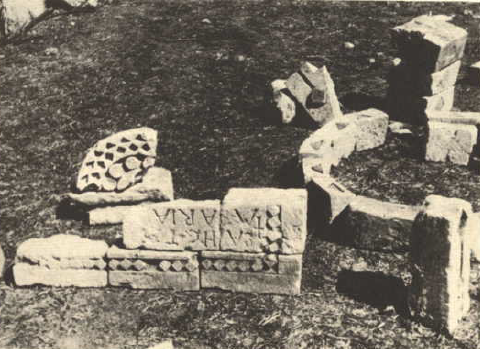The Stone Specialist’s workshop: architectural elements
South of the Columbaris rooms of worship there is the craftsmen’s quarter, arranged around a central space, in addition to the probable bishop’s residence (fig. 1). Among the presumed workshops a mason’s workshop has been identified (fig. 2) on the south side of the courtyard, characterised by the presence of a counter on three sides, while the latter was occupied b a staircase, which seemed to have been used up to the 7th cen-tury A.D.


This use was hypothesised due to the presence of stone material, both rough and sculpt-ed, inside. There are various types of items found: there are funeral elements such as sar-cophagi, fragments of religious furnishings (canteen and relative columns) and architec-tural items (columns, capitals...). The decorative limestone and marble blocks found in the northern pastophorium of the baptistery come from the same workshop.
Some limestone fragments can be traced to an inscription - which is missing in some parts - that carries the name of the Virgin Mary (fig. 4), St John and Saint Paul. It is possi-ble that one of the three basilicas in the Columbaris complex was dedicated to each saint: the cathedral to Mary, the baptistery to St John the Baptist and the cemetery basil-ica to St Paul. The date of this inscription ranges from the 6th to the 9th century A.D.


The elements with engraved decorations are characterised by limestone blocks with red trachyte geometric inserts (fig. 5) that can be dated to the 7th century.

Other elements that are part of the sculpted decoration like the capital-imposts, the shelves with the acanthus leaf, a capital with fish, a roughly hewn shelf in the body of a statue and a capital-impost made out of an architectural element.
Bibliografia
- R. CAPRARA, Tarda Antichità e Medioevo, in F. LO SCHIAVO (a cura di), Il Museo Sanna in Sassari, Sassari 1986, pp. 169-184.
- R. CORONEO, La cultura artistica, in P. CORRIAS, S. COSENTINO (a cura di), Ai confini dell’impero: storia, arte e archeologia della Sardegna bizantina, Cagliari 2002, Cagliari 2002, pp. 99-107.
- R. CORONEO, Arte in Sardegna dal IV alla metà dell’XI secolo, Cagliari 2011, pp. 87, 266-268.
- G. FARRIS, Le aree paleocristiane di Cornus, Oristano 1993, pp. 122, 131-136.
- A. M. GIUNTELLA, Cornus I.1. L'area cimiteriale orientale = Mediterraneo tardoantico e medievale. Scavi e ricerche, 13. 1, Oristano 1999, pp. 44, 46, 79, 200.
- G. MAETZKE, Scavi e scoperte nel campo dell’archeologia cristiana negli ultimi dieci anni in Toscana e in Sardegna, in Atti del II Congresso Nazionale di Archeologia Cristiana (Matera, Venosa, Melfi, Massafra, Taranto, Canosa, Foggia 25-31 maggio 1969), Roma 1971, pp. 311-336.
- R. MARTORELLI, Riflessioni sulle attività produttive nell’età tardoantica e altomedievale: esiste un artigianato “ecclesiastico”?, in Rivista di Archeologia Cristiana, LXXV, pp. 571-596.
- A. MASTINO, Cornus nella storia degli studi con un catalogo delle iscrizioni rinvenute nel territorio del comune di Cuglieri, Cagliari 1984, pp. 166-171.
- L. PANI ERMINI, Un piccolo bronzo da Cornus raffigurante S. Paolo, Roma 1989, in Atti della Pontificia Accademia romana di archeologia. Rendiconti, 61, (1988/89), 1990, pp. 3-25.
- L. PANI ERMINI, R. ZUCCA, L'età paleocristiana e altomedievale: la produzione artigianale e l'epigrafia, in V. SANTONI (a cura di), Il Museo Archeologico Nazionale di Cagliari, Sassari 1989, pp. 247-286.
- V. SANTONI, Una statuina in bronzo raffigurante San Paolo dall'area cimiteriale di Cornus, in P. G. SPANU (a cura di), con la collaborazione di M. C. OPPO e A. BONINU, Insulae Christi. Il cristianesimo primitivo in Sardegna, Corsica e Baleari = Mediterraneo tardoantico e medievale. Scavi e ricerche 16, Oristano 2002, pp. 277-280.
- P. G. SPANU, La Sardegna bizantina tra VI e VII secolo, Oristano 1998, pp. 73, 102-103.
- P. G. SPANU, Le sedi diocesane della Sardinia in età bizantina: alcune note d’aggiornamento, in R. M. BONACASA CARRA, E. VITALE (a cura di), La cristianizzazione in Italia fra Tardoantico e Altomedioevo. Atti del IX Congresso Nazionale di Archeologia Cristiana (Agrigento 20-25 novembre 2004), II, Palermo 2007, pp. 1449-1468.
- P. TESTINI, Il complesso paleocristiano di Cornus (Regione Columbaris) in Sardegna, in Actas del VIII Congreso Internacional de Arqueologia Cristiana (Barcelona, 5-11 octubre 1969), Barcellona 1972, pp. 537-561.

 VR
VR